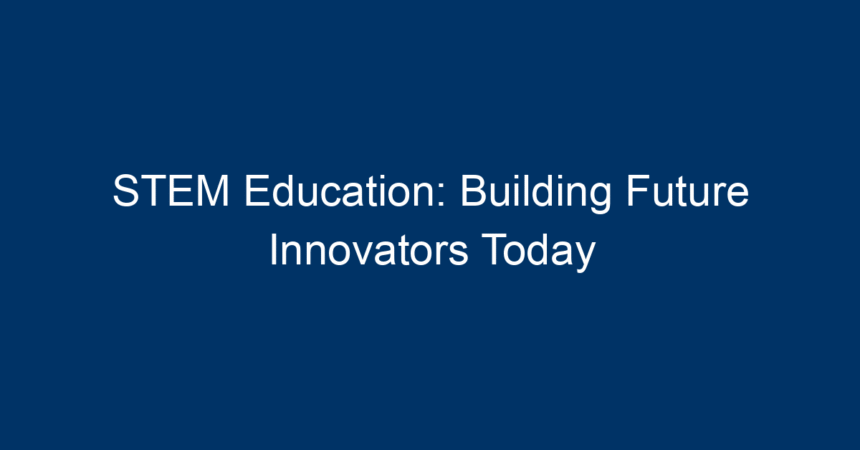In an ever-evolving world driven by technology, the importance of STEM education cannot be overstated. STEM, which stands for Science, Technology, Engineering, and Mathematics, is not just a curriculum; it is a transformative approach to learning that harnesses critical thinking, creativity, and problem-solving skills. As we stand on the cusp of a new era, integrating STEM education into our schools is paramount for cultivating the innovators of tomorrow.
Why STEM Education Matters
The Demand for STEM Professionals
As societies grow increasingly reliant on technology, the demand for skilled professionals in STEM fields is soaring. According to the U.S. Bureau of Labor Statistics, jobs in STEM fields are projected to grow by 8% through 2029, compared to 3.7% for non-STEM jobs. This stark contrast highlights the urgent need for students to engage with STEM subjects early on in their education.
Encouraging Critical Thinking and Problem Solving
STEM education encourages students to ask questions, analyze data, and approach problems methodically. This engagement fosters critical thinking and creativity, equipping them with the tools to tackle complex challenges in the real world. By nurturing these essential skills, we are helping to mold a generation of thinkers who will drive innovation and societal progress.
The Pillars of STEM Education
1. Science: Exploring the World Around Us
Science is fundamental to understanding our universe, from the tiniest cells to vast galaxies. STEM education places an emphasis on experiential learning, allowing students to conduct experiments and explore scientific concepts hands-on. This practical approach deepens their understanding and inspires curiosity.
Real-world Applications
Whether it’s learning about ecosystems in biology or the principles of physics in motion, science education prepares students to apply theories in real-world situations. Engaging activities like science fairs and field trips to laboratories or nature reserves provide an exciting context for learning.
2. Technology: Embracing the Digital Age
In today’s digital landscape, technological proficiency is essential. STEM education integrates technology into the curriculum, teaching students not only how to use various tools but also how to innovate with them. This engagement includes programming, robotics, and digital design, providing students with valuable skills for future careers.
Coding as the New Literacy
Learning to code is increasingly recognized as a vital skill. Programs like Scratch, Code.org, and robotics clubs help students develop computational thinking and problem-solving skills while making technology accessible and fun.
3. Engineering: Designing Solutions
Engineering teaches students to design and construct solutions to real-world problems. Through hands-on projects, students learn about the engineering design process, from brainstorming and prototyping to testing and refining their ideas. This practical experience not only makes learning enjoyable but also fosters teamwork and communication skills.
The Maker Movement
The Maker Movement has revolutionized how students engage with engineering. By providing access to tools like 3D printers, laser cutters, and electronics kits, students can bring their ideas to life, nurturing a culture of innovation.
4. Mathematics: The Language of Logic
Mathematics is the foundation for many STEM disciplines. Creating a strong mathematical foundation is crucial for students to succeed in advanced STEM courses. STEM education employs engaging methods to teach math, utilizing real-world applications to demonstrate its relevance.
Engaging with Math
Games, puzzles, and problem-solving challenges can demystify mathematics for students. With a focus on teaching for understanding rather than rote memorization, educators can inspire a love for math that will stay with students for life.
Integrating STEM into Schools
Curriculum Development
For effective STEM education, schools need to integrate STEM concepts across the curriculum. This interdisciplinary approach encourages collaboration among teachers from different subject areas and allows students to make connections between disciplines.
Project-Based Learning
Project-based learning (PBL) is an effective way to implement STEM education. PBL involves students working on a project over an extended period, linking theoretical knowledge with practical application. This active learning environment fosters collaboration and instills a sense of ownership in students over their learning.
Community Partnerships
Building partnerships with local businesses, colleges, and organizations can significantly enhance STEM education programs. These collaborations create opportunities for students to engage in internships, mentorships, and real-world projects, bridging the gap between classroom learning and industry applications.
The Role of Parents in Supporting STEM Education
Encouraging Curiosity at Home
Parents play a crucial role in promoting STEM education at home. Encouraging curiosity and exploration through science experiments, math games, or technology projects can reinforce what students learn in school.
Supporting STEM Events
Participating in local STEM events, such as science fairs or robotics competitions, can further stimulate children’s interest in these fields. By engaging with their communities, parents can provide their children with unique opportunities to connect with the broader STEM ecosystem.
Challenges in STEM Education
Equity in Access
One of the significant challenges in STEM education is the equity of access. Many students, particularly in underprivileged areas, lack access to the necessary resources and opportunities in STEM fields. Schools and policymakers must work to ensure that all students have equal access to high-quality STEM education, regardless of their background.
Teacher Professional Development
Teachers must be adequately prepared to teach STEM subjects. Ongoing professional development is vital to equip educators with the latest pedagogical strategies and subject knowledge, ensuring they can effectively inspire their students in STEM.
Conclusion: Shaping the Innovators of Tomorrow
STEM education is not just about teaching students the four subjects; it’s about building a mindset that values curiosity, fosters innovation, and equips learners with skills for the future. As we face global challenges, the need for skilled STEM professionals has never been more critical.
By prioritizing STEM education, integrating it into our schools, and engaging students in hands-on learning experiences, we can cultivate a new generation of innovators who are ready to tackle the challenges of tomorrow.
Actionable Insights
- For Educators: Integrate STEM concepts across all subjects and emphasize project-based learning to foster collaboration and creativity.
- For Parents: Engage in STEM activities at home and support local STEM events to nurture your child’s interest.
- For Policymakers: Advocate for equitable access to STEM resources and professional development programs for educators.
By taking these steps, we can ensure that our children are not only prepared for the future but are also inspired to lead it. Embrace STEM education today to build a brighter tomorrow!




